Age: 53
Sex: Female
Indication: Left eye blindness
Save ("V")
Case #37
Findings
- T2/FLAIR signal hyperintensity in the left sphenoid sinus, left greater than right maxillary sinuses, and throughout bilateral ethmoid air cells
- Left periorbital and postseptal T2/FLAIR signal hyperintensity and enhancement with slight left proptosis
- T2/FLAIR signal hyperintensity and enhancement in the left masticator space involving the left muscles of mastication and extending into the left parapharyngeal space
- No peripherally enhancing collection
- Restricted diffusion involving the orbital and canalicular segments of the left optic nerve
- Abnormal T2 hypointensity in the left foramen ovale and left Meckel’s cave with restricted diffusion involving the cisternal segment of the left trigeminal nerve extending into the left dorsolateral pons and left Meckel’s cave
- Asymmetric hypoenhancement of the left superior ophthalmic vein and left cavernous sinus
- No convincing contrast opacification of the left ophthalmic artery, though the ophthalmic segment of the left internal carotid artery opacifies
- Hypoenhancement of the left middle and inferior nasal turbinates
Diagnosis
- Cavernous sinus thrombosis
- Invasive mucormycosis
 Sample Report
Sample Report
Findings highly concerning for invasive fungal sinusitis with sinus disease involving the left sphenoid sinus, left greater than right maxillary sinuses, and bilateral ethmoid air cells and contiguous extension with left preseptal and postseptal orbital cellulitis, cellulitis/myositis involving the left masticator and parapharyngeal spaces, and evidence of intracranial extension with left superior ophthalmic vein and left cavernous sinus thrombosis. No peripherally enhancing collection to suggest abscess. No convincing enhancement of the left ophthalmic artery is concerning for thrombosis, which could be further evaluated with CTA or catheter angiography. Recommend urgent surgical consultation.
Restricted diffusion involving the orbital and canalicular segments of the left optic nerve concerning for infectious involvement and/or infarct.
Findings consistent with perineural spread of infection along the V3 branch of the left trigeminal nerve from the left masticator space, through foramen ovale, and involving the left Meckel’s cave with further retrograde extension along the cisternal segment of the left trigeminal nerve into the left dorsolateral pons.
Hypoenhancement of the left middle and inferior nasal turbinates concerning for necrosis.
Discussion
📣 Feedback?
⌨️ Keyboard Shortcuts ("K")
Help | Terms | Privacy Policy | Cookie Policy
Medical Disclaimer | © 2024 CaseStacks LLC
Related Cases
References
- Aribandi M, McCoy V, Bazan C. Imaging features of invasive and noninvasive fungal sinusitis: a review. Radiographics 2007; 27: 1283-1296.
- Herrera DA, Dublin AB, Ormsby EL, Aminpour S, Howell LP. Imaging findings of rhinocerebral mucormycosis. Skull Base 2009; 19(2): 117-125.
- Mahalingam HV, Mani SE, Patel B, Prabhu K, Alexander M, Fatterpekar GM, Chacko G. Imaging Spectrum of Cavernous Sinus Lesions with Histopathologic Correlation. Radiographics 2019; 39: 795-819.


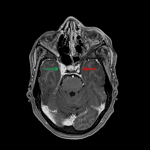
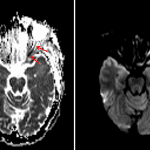
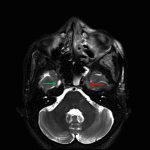
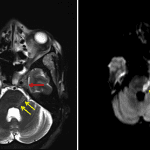
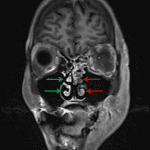

 View shortcuts
View shortcuts Zoom/Pan
Zoom/Pan Full screen
Full screen Window/Level
Window/Level Expand/collapse
Expand/collapse Scroll
Scroll Save the case
Save the case Close case/tab
Close case/tab





 Previous series (if multiple)
Previous series (if multiple) Next series (if multiple)
Next series (if multiple)
